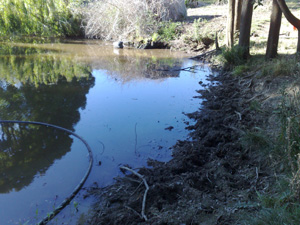A preliminary investigation was carried out on the quality of water in two dams on a dairy farm in West Gippsland. The dams are a short distance apart in the same gully. The Upper dam is spring fed and can overflow into the Lower dam. The water was tested during summer. At that time the flow into the Upper dam had decreased and the water level was falling. The Lower dam was still fairly full.
The dams are in an elevated position and drain approximately 10 ha. The surrounding land is pasture.

There are many waterbirds on the dams – mainly ducks. Cows have access to both dams and commonly drink at the water’s edge. The water in both dams has a pale yellow-brown colour. There is significant attached bacterial – fungal mats clearly visible in shallow water. One significant observation was that were no visible micro crustaceans.
| Dam | CO2 | EC | Turbidity | Reactive C | ORP* |
| ppm | microS/cm | FTU | mg/L | mV | |
| Upper | 18 | 289 | 11.5 | 0.5 | 207 |
| elevated | sl. elevated | sl. cloudy | moderate | OK | |
| Lower | 5.8 | 738 | 3.5 | 0.5 | 205 |
| moderate | elevated | clear | moderate | OK | |
| * oxidation reduction potential | |||||
Some key findings are: Dissociated carbon dioxide was high in the Upper dam. The water is fairly clear in both dams with the Upper dam water just slightly cloudy. Overall salts as conductivity are elevated in the Lower dam. Both dams have oxidizing potential (a surrogate for oxygen level) within the desirable range.
Reactive or relatively fresh organic matter was estimated by permanganate digestion. In both dams reactive organic matter was in the moderately elevated range. Humic material in dams can be measured indirectly by UV absorbance. In both dams the UV absorbance was high, around 65%.
The pH of the Upper dam was 7.2 and pH of the Lower dam was 6.8. A pH buffer system analysis of the Upper dam gives a calculated pH of 6.7. This suggested the scenario of a falling pH (water becoming more acidic) as the carbon dioxide level rises. In this case the rise in carbon dioxide is being most likely caused by increasing organic matter decomposition. See organic matter figures below.
A pH buffer system analysis for the Lower dam gives theoretical pH of 7.84. This suggests that carbon dioxide level in this water is falling and this will cause the pH to slowly rise (the water will become more alkaline).

| Dam | E. coli | coliforms | TC* |
| CFU’s / 100 ml | CFU’s / 100 ml | CFU’s / 100 ml | |
| Upper | 440 | 3317 | 53281 |
| elevated** | high | moderate | |
| Lower | 960 | 7119 | 118274 |
| elevated** | elevated** | sl. elevated | |
| * aerobic plate count | |||
| ** indicates contamination | |||
For both dams the high E coli level taken along with the high coliform levels indicate some fecal contamination of the water. Total aerobic bacteria level is approximately in the moderate range for exposed waters.
The main quality issue in both dams is elevated reactive organic matter levels and elevated E coli bacteria levels. There is some evidence that processes in the Lower dam are at least slowing deterioration of water quality. However on the negative side, levels of bacteria are significantly higher in the Lower dam.
Ideally in a study like this it would be useful to test the source water, in this case the spring water entering the dams. Unfortunately the spring was not accessible. There was also no other dam on the property to provide a comparison.